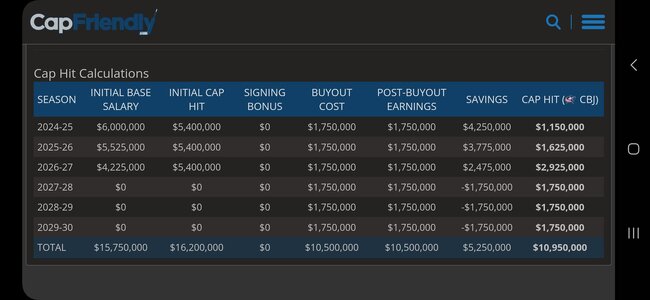just because i'm not the one physically writing the check doesn't mean i can't look at the situation and assert that there is a clear better course of action.
trading him with 50% retained
- $8.1m dead cap over next three years ($2.7/year)
- 24-25 cap: $87.7m (dead cap = 3% of that)
- 25-26 proj. cap: $92m (dead cap = 2.9%)
- 26-27 estimate: $95m (dead cap = 2.8%)
- $8.1m cap savings (vs keeping him) over that three-year span
- percentages of cap savings are the same as the dead cap percentages above
- potential need to take money back (-cap)
- likely need to attach assets as sweetener (-assets)
- takes up 1/3 retention slots for next three years (-retention slot)
- opportunity cost of not having one of those retention slots
versus buying him out
- $10.5m dead cap over next six years ($1.75m/year)
- 24-25 cap: $87.7m (dead cap = 2%)
- 25-26 proj: $92m (1.9%)
- 26-27 est: $95m (1.8%)
- 27-28 est: $98m (1.78%)
- 28-29 est: $101m (1.7%)
- 29-30 est: $104m ($1.68%)
- $10.5m cap savings across the next three years
- frees up 4.8% of the cap next year, 4.1% in 25-26, 2.6% in 26-27
- additional cap savings in next two years allows them to take on a salary dump from a cap-strapped team (+assets)
- no trade necessary
- keeps asset(s) they'd need to use as sweetener, can be used for something else (+opportunity)
- no need to take money back in trade (+cap)
- keeps an open retention slot for three years, can be used to:
- increase return on other trades (+assets)
- act as retention broker for next three deadlines (+assets)
the difference in total cash out is $2.4m. a couple years ago, the wild got a fourth rounder to retain about $2m of cap in the o'reilly trade. so let's split the difference and say that, in a vacuum, trading elvis at 50% for future considerations will save them the cash equivalent of a fourth round pick.
but that's on the assumption that someone would take him for free at 50%. it's likely that the jackets would need to attach an asset worth more than a 4th rounder. so that washes out the advantage of the trade vs buyout right there.
then there's the opportunity cost – having the open retention slot + extra cap the next three years can
easily net them far more than a fourth-round pick (teams give up 1sts to dump contracts, and they'd have three deadlines to act as a retention broker on top of that).
that flexibility (and potential impact of the moves it enables) is worth
far more than a fourth round pick. advantage buyout.
they have more
years with dead cap, but the
percentage of dead cap in those years is insignificant. not exactly 'brutal' – should be quite easy to manage.
unless they can find someone to take him without any retention or need to attach significant (2nd round equivalent or higher) assets, the buyout is clearly the correct course of action.


